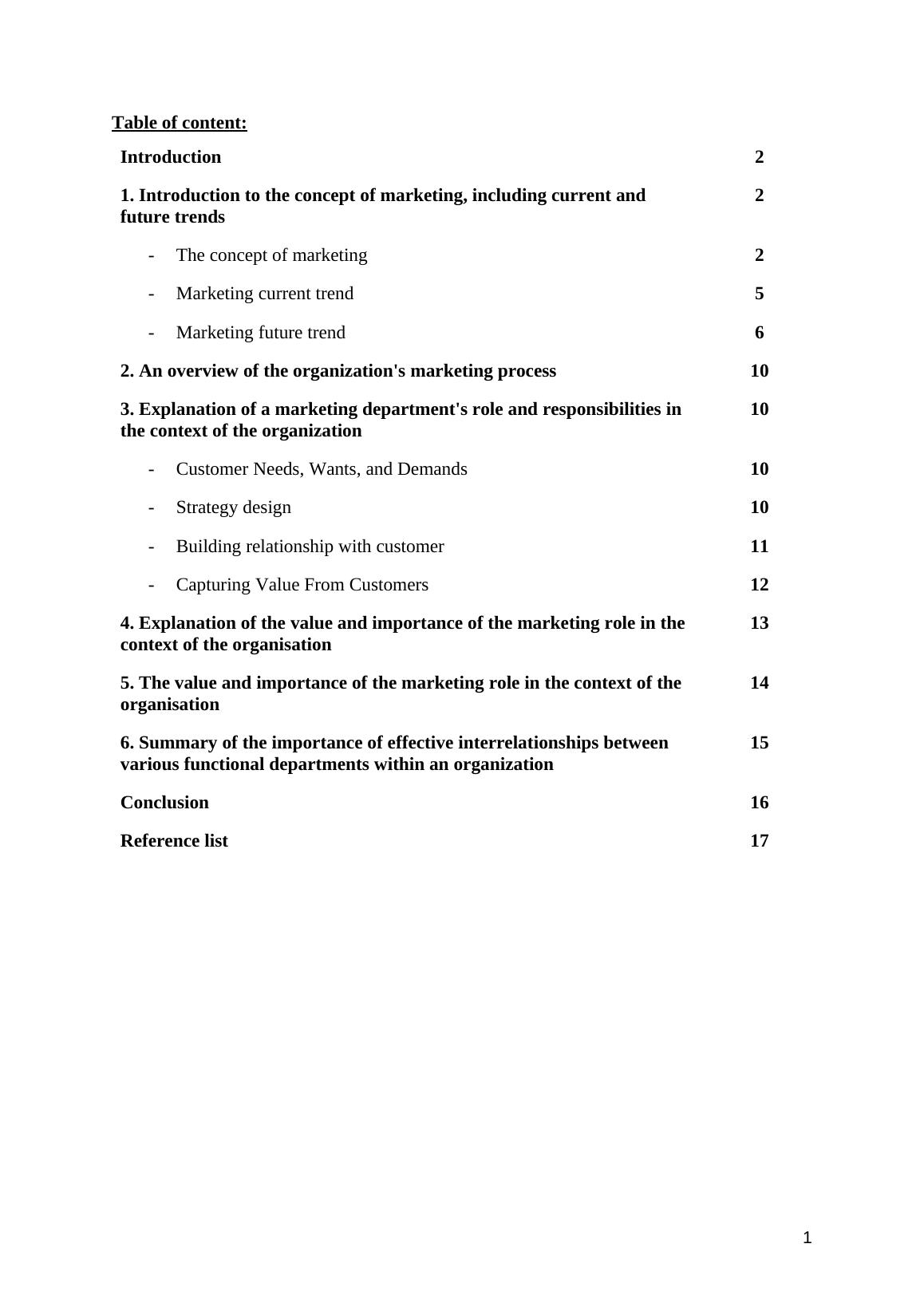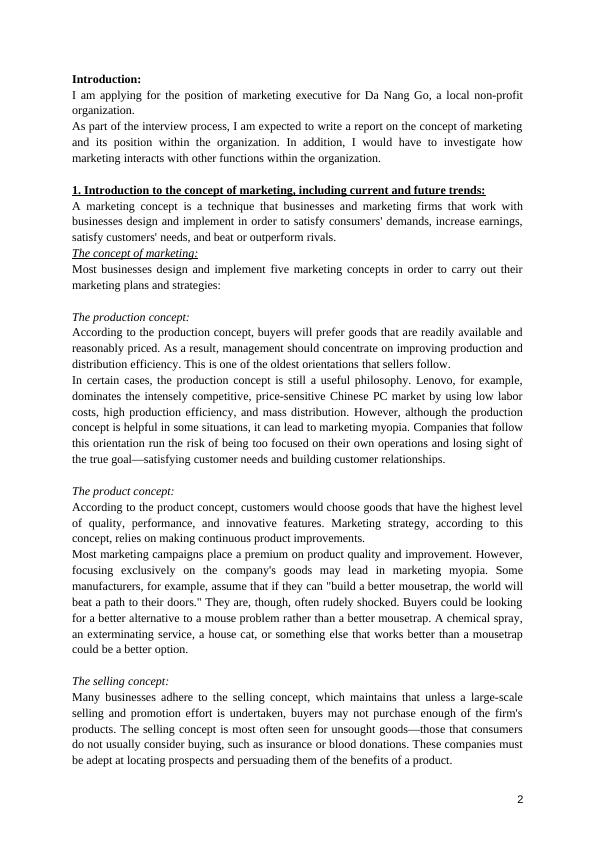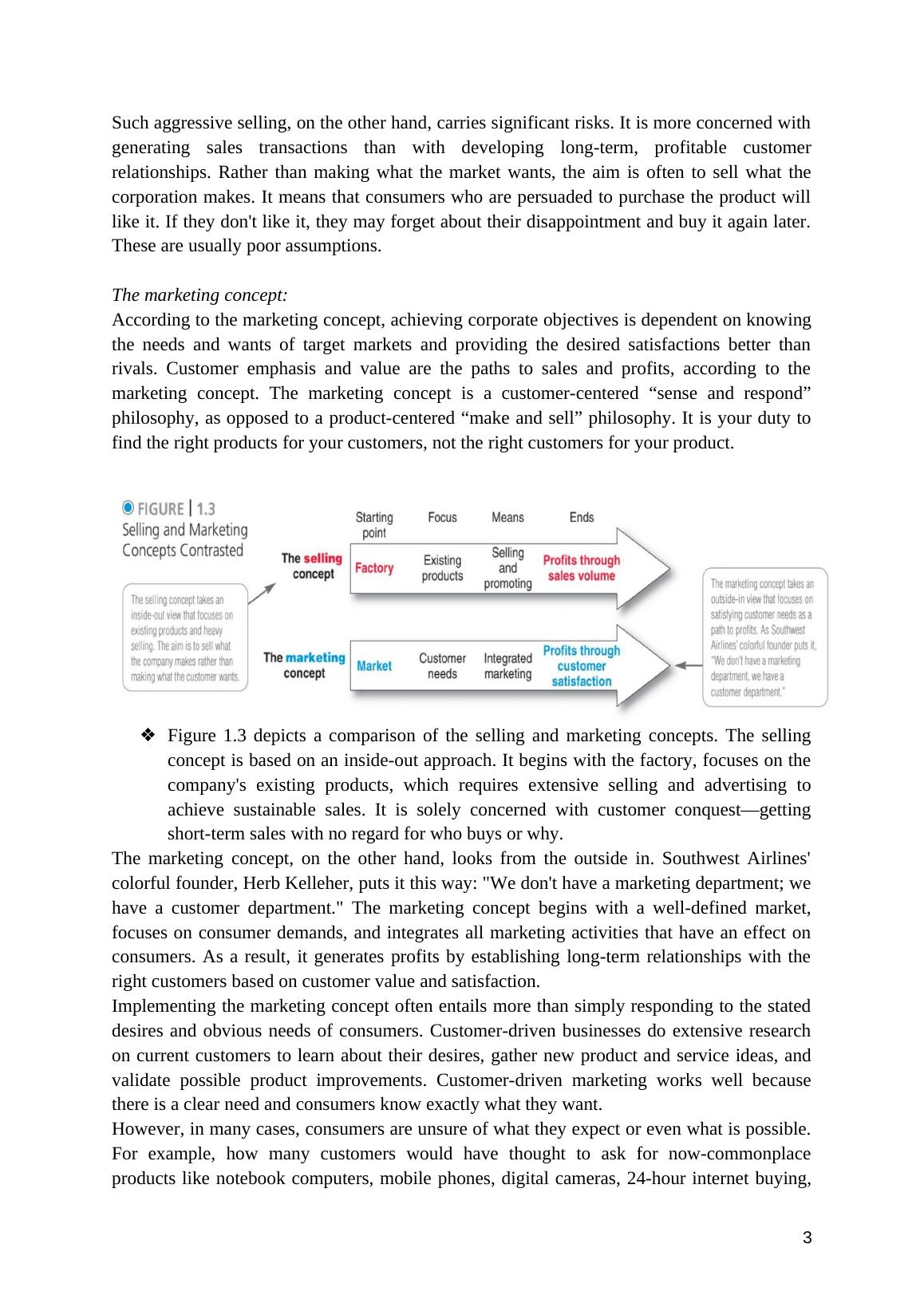Current and Future Trends in Marketing - Assignment
Added on 2021-11-23
17 Pages6545 Words51 Views
Table of content:
Introduction 2
1. Introduction to the concept of marketing, including current and
future trends
2
- The concept of marketing 2
- Marketing current trend 5
- Marketing future trend 6
2. An overview of the organization's marketing process 10
3. Explanation of a marketing department's role and responsibilities in
the context of the organization
10
- Customer Needs, Wants, and Demands 10
- Strategy design 10
- Building relationship with customer 11
- Capturing Value From Customers 12
4. Explanation of the value and importance of the marketing role in the
context of the organisation
13
5. The value and importance of the marketing role in the context of the
organisation
14
6. Summary of the importance of effective interrelationships between
various functional departments within an organization
15
Conclusion 16
Reference list 17
1
Introduction 2
1. Introduction to the concept of marketing, including current and
future trends
2
- The concept of marketing 2
- Marketing current trend 5
- Marketing future trend 6
2. An overview of the organization's marketing process 10
3. Explanation of a marketing department's role and responsibilities in
the context of the organization
10
- Customer Needs, Wants, and Demands 10
- Strategy design 10
- Building relationship with customer 11
- Capturing Value From Customers 12
4. Explanation of the value and importance of the marketing role in the
context of the organisation
13
5. The value and importance of the marketing role in the context of the
organisation
14
6. Summary of the importance of effective interrelationships between
various functional departments within an organization
15
Conclusion 16
Reference list 17
1

Introduction:
I am applying for the position of marketing executive for Da Nang Go, a local non-profit
organization.
As part of the interview process, I am expected to write a report on the concept of marketing
and its position within the organization. In addition, I would have to investigate how
marketing interacts with other functions within the organization.
1. Introduction to the concept of marketing, including current and future trends:
A marketing concept is a technique that businesses and marketing firms that work with
businesses design and implement in order to satisfy consumers' demands, increase earnings,
satisfy customers' needs, and beat or outperform rivals.
The concept of marketing:
Most businesses design and implement five marketing concepts in order to carry out their
marketing plans and strategies:
The production concept:
According to the production concept, buyers will prefer goods that are readily available and
reasonably priced. As a result, management should concentrate on improving production and
distribution efficiency. This is one of the oldest orientations that sellers follow.
In certain cases, the production concept is still a useful philosophy. Lenovo, for example,
dominates the intensely competitive, price-sensitive Chinese PC market by using low labor
costs, high production efficiency, and mass distribution. However, although the production
concept is helpful in some situations, it can lead to marketing myopia. Companies that follow
this orientation run the risk of being too focused on their own operations and losing sight of
the true goal—satisfying customer needs and building customer relationships.
The product concept:
According to the product concept, customers would choose goods that have the highest level
of quality, performance, and innovative features. Marketing strategy, according to this
concept, relies on making continuous product improvements.
Most marketing campaigns place a premium on product quality and improvement. However,
focusing exclusively on the company's goods may lead in marketing myopia. Some
manufacturers, for example, assume that if they can "build a better mousetrap, the world will
beat a path to their doors." They are, though, often rudely shocked. Buyers could be looking
for a better alternative to a mouse problem rather than a better mousetrap. A chemical spray,
an exterminating service, a house cat, or something else that works better than a mousetrap
could be a better option.
The selling concept:
Many businesses adhere to the selling concept, which maintains that unless a large-scale
selling and promotion effort is undertaken, buyers may not purchase enough of the firm's
products. The selling concept is most often seen for unsought goods—those that consumers
do not usually consider buying, such as insurance or blood donations. These companies must
be adept at locating prospects and persuading them of the benefits of a product.
2
I am applying for the position of marketing executive for Da Nang Go, a local non-profit
organization.
As part of the interview process, I am expected to write a report on the concept of marketing
and its position within the organization. In addition, I would have to investigate how
marketing interacts with other functions within the organization.
1. Introduction to the concept of marketing, including current and future trends:
A marketing concept is a technique that businesses and marketing firms that work with
businesses design and implement in order to satisfy consumers' demands, increase earnings,
satisfy customers' needs, and beat or outperform rivals.
The concept of marketing:
Most businesses design and implement five marketing concepts in order to carry out their
marketing plans and strategies:
The production concept:
According to the production concept, buyers will prefer goods that are readily available and
reasonably priced. As a result, management should concentrate on improving production and
distribution efficiency. This is one of the oldest orientations that sellers follow.
In certain cases, the production concept is still a useful philosophy. Lenovo, for example,
dominates the intensely competitive, price-sensitive Chinese PC market by using low labor
costs, high production efficiency, and mass distribution. However, although the production
concept is helpful in some situations, it can lead to marketing myopia. Companies that follow
this orientation run the risk of being too focused on their own operations and losing sight of
the true goal—satisfying customer needs and building customer relationships.
The product concept:
According to the product concept, customers would choose goods that have the highest level
of quality, performance, and innovative features. Marketing strategy, according to this
concept, relies on making continuous product improvements.
Most marketing campaigns place a premium on product quality and improvement. However,
focusing exclusively on the company's goods may lead in marketing myopia. Some
manufacturers, for example, assume that if they can "build a better mousetrap, the world will
beat a path to their doors." They are, though, often rudely shocked. Buyers could be looking
for a better alternative to a mouse problem rather than a better mousetrap. A chemical spray,
an exterminating service, a house cat, or something else that works better than a mousetrap
could be a better option.
The selling concept:
Many businesses adhere to the selling concept, which maintains that unless a large-scale
selling and promotion effort is undertaken, buyers may not purchase enough of the firm's
products. The selling concept is most often seen for unsought goods—those that consumers
do not usually consider buying, such as insurance or blood donations. These companies must
be adept at locating prospects and persuading them of the benefits of a product.
2

Such aggressive selling, on the other hand, carries significant risks. It is more concerned with
generating sales transactions than with developing long-term, profitable customer
relationships. Rather than making what the market wants, the aim is often to sell what the
corporation makes. It means that consumers who are persuaded to purchase the product will
like it. If they don't like it, they may forget about their disappointment and buy it again later.
These are usually poor assumptions.
The marketing concept:
According to the marketing concept, achieving corporate objectives is dependent on knowing
the needs and wants of target markets and providing the desired satisfactions better than
rivals. Customer emphasis and value are the paths to sales and profits, according to the
marketing concept. The marketing concept is a customer-centered “sense and respond”
philosophy, as opposed to a product-centered “make and sell” philosophy. It is your duty to
find the right products for your customers, not the right customers for your product.
❖Figure 1.3 depicts a comparison of the selling and marketing concepts. The selling
concept is based on an inside-out approach. It begins with the factory, focuses on the
company's existing products, which requires extensive selling and advertising to
achieve sustainable sales. It is solely concerned with customer conquest—getting
short-term sales with no regard for who buys or why.
The marketing concept, on the other hand, looks from the outside in. Southwest Airlines'
colorful founder, Herb Kelleher, puts it this way: "We don't have a marketing department; we
have a customer department." The marketing concept begins with a well-defined market,
focuses on consumer demands, and integrates all marketing activities that have an effect on
consumers. As a result, it generates profits by establishing long-term relationships with the
right customers based on customer value and satisfaction.
Implementing the marketing concept often entails more than simply responding to the stated
desires and obvious needs of consumers. Customer-driven businesses do extensive research
on current customers to learn about their desires, gather new product and service ideas, and
validate possible product improvements. Customer-driven marketing works well because
there is a clear need and consumers know exactly what they want.
However, in many cases, consumers are unsure of what they expect or even what is possible.
For example, how many customers would have thought to ask for now-commonplace
products like notebook computers, mobile phones, digital cameras, 24-hour internet buying,
3
generating sales transactions than with developing long-term, profitable customer
relationships. Rather than making what the market wants, the aim is often to sell what the
corporation makes. It means that consumers who are persuaded to purchase the product will
like it. If they don't like it, they may forget about their disappointment and buy it again later.
These are usually poor assumptions.
The marketing concept:
According to the marketing concept, achieving corporate objectives is dependent on knowing
the needs and wants of target markets and providing the desired satisfactions better than
rivals. Customer emphasis and value are the paths to sales and profits, according to the
marketing concept. The marketing concept is a customer-centered “sense and respond”
philosophy, as opposed to a product-centered “make and sell” philosophy. It is your duty to
find the right products for your customers, not the right customers for your product.
❖Figure 1.3 depicts a comparison of the selling and marketing concepts. The selling
concept is based on an inside-out approach. It begins with the factory, focuses on the
company's existing products, which requires extensive selling and advertising to
achieve sustainable sales. It is solely concerned with customer conquest—getting
short-term sales with no regard for who buys or why.
The marketing concept, on the other hand, looks from the outside in. Southwest Airlines'
colorful founder, Herb Kelleher, puts it this way: "We don't have a marketing department; we
have a customer department." The marketing concept begins with a well-defined market,
focuses on consumer demands, and integrates all marketing activities that have an effect on
consumers. As a result, it generates profits by establishing long-term relationships with the
right customers based on customer value and satisfaction.
Implementing the marketing concept often entails more than simply responding to the stated
desires and obvious needs of consumers. Customer-driven businesses do extensive research
on current customers to learn about their desires, gather new product and service ideas, and
validate possible product improvements. Customer-driven marketing works well because
there is a clear need and consumers know exactly what they want.
However, in many cases, consumers are unsure of what they expect or even what is possible.
For example, how many customers would have thought to ask for now-commonplace
products like notebook computers, mobile phones, digital cameras, 24-hour internet buying,
3

and satellite navigation systems in their cars even 20 years ago? In such cases, consumer-
driven marketing is needed, which entails knowing customer needs even better than
consumers themselves and designing products and services that meet existing and latent
needs now and in the future. “Our goal is to lead customers where they want to go before
they know where they want to go,” said a 3M executive.
The Societal Marketing Concept
The societal marketing concept questions whether the pure marketing concept ignores
potential conflicts between customer short-run desires and consumer long-run welfare. Is a
business that satisfies the immediate demands and desires of target markets always doing
what is best for its customers in the long run? According to the societal marketing concept,
marketing campaigns should have value to consumers in a manner that preserves or improves
both the consumer's and society's well-being. It advocates for socially and environmentally
responsible marketing that meets the current needs of consumers and companies while also
preserving or improving future generations' ability to meet their future needs.
Consider the bottled water industry of today. Bottled water firms can appear to have a
convenient, tasty, and healthy product. Its packaging conjures up visions of pristine lakes and
snow-capped mountains that are "green." However, the production, filling, and shipping of
billions of plastic bottles produces massive quantities of carbon dioxide emissions, which
contribute significantly to global warming. Furthermore, plastic bottles pose a significant
recycling and solid waste disposal problem. As a result of satisfying short-term consumer
desires, the bottled water industry could be causing environmental problems that are
detrimental to society's long-term interests.
As shown in Figure 1.4, businesses should balance three factors when developing their
marketing strategies: company profits, customer desires, and societal interests. UPS excels at
this. Its respect for societal interests has won it the first or second place in Fortune magazine's
Most Admired Companies for Social Responsibility rankings four of the last five years.
UPS seeks more than just short-run sales and profits. Its three-pronged corporate
sustainability mission stresses economic prosperity (profitable growth through a customer
focus), social responsibility (community engagement and individual well-being), and
environmental stewardship (operating efficiently and protecting the environment). Whether it
involves greening up its operations or urging employees to volunteer time in their
communities, UPS proactively seeks opportunities to act responsibly. UPS knows that doing
4
driven marketing is needed, which entails knowing customer needs even better than
consumers themselves and designing products and services that meet existing and latent
needs now and in the future. “Our goal is to lead customers where they want to go before
they know where they want to go,” said a 3M executive.
The Societal Marketing Concept
The societal marketing concept questions whether the pure marketing concept ignores
potential conflicts between customer short-run desires and consumer long-run welfare. Is a
business that satisfies the immediate demands and desires of target markets always doing
what is best for its customers in the long run? According to the societal marketing concept,
marketing campaigns should have value to consumers in a manner that preserves or improves
both the consumer's and society's well-being. It advocates for socially and environmentally
responsible marketing that meets the current needs of consumers and companies while also
preserving or improving future generations' ability to meet their future needs.
Consider the bottled water industry of today. Bottled water firms can appear to have a
convenient, tasty, and healthy product. Its packaging conjures up visions of pristine lakes and
snow-capped mountains that are "green." However, the production, filling, and shipping of
billions of plastic bottles produces massive quantities of carbon dioxide emissions, which
contribute significantly to global warming. Furthermore, plastic bottles pose a significant
recycling and solid waste disposal problem. As a result of satisfying short-term consumer
desires, the bottled water industry could be causing environmental problems that are
detrimental to society's long-term interests.
As shown in Figure 1.4, businesses should balance three factors when developing their
marketing strategies: company profits, customer desires, and societal interests. UPS excels at
this. Its respect for societal interests has won it the first or second place in Fortune magazine's
Most Admired Companies for Social Responsibility rankings four of the last five years.
UPS seeks more than just short-run sales and profits. Its three-pronged corporate
sustainability mission stresses economic prosperity (profitable growth through a customer
focus), social responsibility (community engagement and individual well-being), and
environmental stewardship (operating efficiently and protecting the environment). Whether it
involves greening up its operations or urging employees to volunteer time in their
communities, UPS proactively seeks opportunities to act responsibly. UPS knows that doing
4

End of preview
Want to access all the pages? Upload your documents or become a member.
Related Documents
Sales & Marketing : Introduction to marketinglg...
|97
|32957
|49
Key roles and responsibilities of marketing in IKEAlg...
|17
|4989
|284
Marketing Plan for Launching a Luxury Hotel: Analysis of Marriott International's 7Ps Strategylg...
|24
|5640
|439
Marketing Principlelg...
|25
|3260
|54
Assignment: Introduction to Marketing Managementlg...
|31
|1435
|73
Marketing Essential For ALDIlg...
|21
|7354
|490
